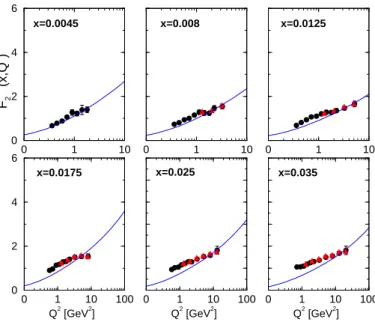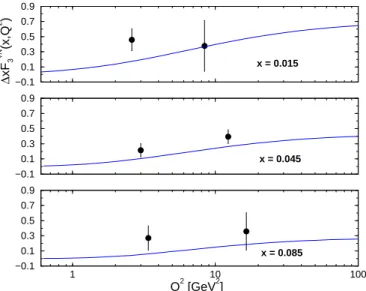Brazilian Journal of Physics, vol. 37, no. 2C, June, 2007 807
Neutrino Structure Functions in the QCD Dipole Picture
M. B. Gay Ducati, M. M. Machado,
High Energy Physics Phenomenology Group, GFPAE, IF-UFRGS Caixa Postal 15051, CEP 91501-970, Porto Alegre, RS, Brazil
and M. V. T. Machado
Centro de Ciˆencias Exatas e Tecnol´ogicas, Universidade Federal do Pampa Campus de Bag´e, Rua Carlos Barbosa. CEP 96400-970. Bag´e, RS, Brazil
Received on 30 October, 2006; revised version received on 24 January, 2007
In this contribution we present an exploratory QCD analysis of the neutrino structure functions in charged current DIS using the color dipole formalism. The corresponding dipole cross sections are taken from recent phenomenological and theoretical studies in deep inelastic inclusive production, including nuclear shadowing corrections. The theoretical predictions are compared to the available experimental results in the small-xregion.
Keywords: Deeply inelastic neutrino-nucleus scattering; Small-xphysics; Parton saturation models
I. INTRODUCTION
The interaction of high energy neutrinos on hadron tar-gets are an outstanding probe to test Quantum Chromodynam-ics (QCD) and understanding the parton properties of hadron structure. The several combinations of neutrino and anti-neutrino scattering data can be used to determine the struc-ture functions, which constrain the valence, sea and gluon par-ton distributions in the nucleons/nuclei. The comparison be-tween neutrino and charged-lepton experimental data can be also used to investigate the universality of the parton distrib-utions. The differential cross section for the neutrino-nucleon charged current processνl(ν¯l) +N→l−(l+) +X, in terms of the Lorentz invariant structure functionsF2νN, 2xF1νN and xF3νNare [1],
dσν,ν¯
dx dy =
G2FmNEν π
·µ
1−y−mNxy 2Eν
¶
F2(x,Q2)
+ y
2
2 2xF1(x,Q 2)±y³
1−y 2 ´
xF3(x,Q2) ¸
, (1)
where GF is the weak Fermi coupling constant, mN is the nucleon mass, Eν is the incident neutrino energy,Q2 is the square of the four-momentum transfer to the nucleon. The variable y=Ehad/Eν is the fractional energy transferred to the hadronic vertex with Ehad being the measured hadronic energy, andx=Q2/2mNEνyis the Bjorken scaling variable (fractional momentum carried by the struck quark).
Similarly to the charged-lepton DIS, the deep inelastic neu-trino scattering is also used to investigate the structure of nu-cleons and nuclei. In the leading order quark-parton model (the QCD collinear approach), the structure functionF2is the singlet distribution,F2νN∝xqS=x∑(q+q¯), the sum of mo-mentum densities of all interacting quarks constituents, and xF3 is the non-singlet distribution, xF3νN ∝xqNS=x∑(q−
¯
q) =xuV+xdV, the valence quark momentum density. These relations are further modified by higher-order QCD correc-tions. The main theory uncertainties are the role played by nuclear shadowing in contrast with lepton-charged DIS and
a correct understanding of the low Q2 limit. The first un-certainty can be better addressed with the future precise data from MINERνA [2] and neutrino-factory [3]. However, nu-clear effects are taken into account by using the nunu-clear ratios R=F2A/AF2pextracted from lepton-nucleus DIS, which could be different for the neutrino-nucleus case. The low-Q2region can not be addressed within the pQCD quark-parton model as a hard momentum scaleQ2
0≥1−2 GeV2is required in order to perform perturbative expansion. In what follows, the neu-trino structure functionF2νN is investigated within the color dipole picture at small-x region. The present calculations are discussed in detail in Ref. [4]. We employ recent phe-nomenological parton saturation models, which are success-ful in describing inclusive deep inelastic data. Nuclear effects are taken into account through Glauber-Gribov formalism and the results are compared to accelerator data. Afterwards, the structure functionxF3and the quantity∆xF3=xF3ν−xF3ν¯are also investigated. The latter quantity provides a determina-tion of the strange-sea parton distribudetermina-tion through charm pro-duction in charged-current neutrino DIS. Finally, we present a brief summary of the main conclusions.
II. NEUTRINO STRUCTURE FUNCTIONF2νN
808 M. B. Gay Ducati, M. M. Machado, and M. V. T. Machado
wave function. The CC DIS structure functions for neutrino-nucleon scattering in the dipole picture [4] are related to the cross section for scattering of transversely and longitudinally polarizedW±bosons. That is,
FTCC,L(x,Q2) = Q
2
4π2 Z
d2r
Z 1
0
dz|ψW±
T,L(z,r,Q2)|2σdip(x,r),(2) whererdenotes the transverse size of the color dipole,zthe longitudinal momentum fraction carried by a quark andψW
T,L are the light-cone wavefunctions for (virtual) charged gauge bosons with transverse or longitudinal polarizations. The small-xneutrino structure functionF2νN is computed from ex-pressions above takingF2=FT+FL. Explicit expressions for the wave functions squared can be found in Ref. [4]. The color dipoles contributing to Cabibbo favored transitions are ud¯(du¯),cs¯(sc¯)for CC interactions. The dipole hadron cross sectionσdipcontains all information about the target and the strong interaction physics.
We consider an analytical expression for the dipole cross section, which presents scaling behavior. Namely, one has
σdip∝(r2Q2sat)γ for dipole sizesr2≈1/Q2sat and whereγ is the effective anomalous dimension. The so-called saturation scaleQsat∝xλ/2defines the onset of the parton saturation ef-fects. In what follows one takes the phenomenological para-meterization of Itakura-Iancu-Munier (IIM) model [6]. It is able to describe experimental data on inclusive and diffrac-tive deep inelastic ep scattering at small-x. The IIM model smoothly interpolates between the limiting behaviors analyt-ically under control: the solution of the BFKL equation for small dipole sizes,r≪1/Qsat(x), and the Levin-Tuchin pre-diction for larger ones, r≫1/Qsat(x). A fit to the structure functionF2(x,Q2)was performed in the kinematical range of interest. The IIM dipole cross section is parameterized as fol-lows,
σIIM
dip(x,r) =σ0 (
N
0 ³¯
τ2
4
´γeff(x,r)
, for ¯τ≤2,
1−exp£−aln2(bτ¯)¤
, for ¯τ>2,
where ¯τ=rQsat(x)and the expression forrQsat(x)>2 (sat-uration region) is an adequate functional form, compatible with approximate or asymptotic solutions of the high energy evolution equations. The coefficientsaandbare determined from the continuity conditions of the dipole cross section at rQsat=2. The coefficientsγsat=0.63 (the BFKL anomalous dimension at the saturation border) andκ=9.9 are fixed from their LO BFKL values. The IIM parameterization presents scaling violation since the effective anomalous dimension de-pends also on the rapidityY =ln(1/x)for small size dipoles,
γ(x,r) =γsat+ln(2κ λY/rQsat). Using the dimensional-cutting rules, we supplement the dipole cross section with a threshold factor
(1−x)nthres, takingn
thres=5.
The extension of the approach to consider nuclei targets we take the Glauber-Gribov picture [7], without any new parame-ter. In this approach, the nuclear version is obtained replacing the dipole-nucleon cross section by the nuclear one,
σnucleus
dip =2 Z
d2b ½
1−exp ·
−1 2TA(b)σ
nucleon
dip (x¯,r2)
¸ ¾
,(3)
0 1 10 100
Q2 [GeV2] 0
2 4
60 1 10
0 2 4 6
F2
ν
N (x,Q 2 )
0 1 10 100
Q2 [GeV2]
0 1 10
0 1 10 100
Q2 [GeV2]
0 1 10
x=0.0045 x=0.008 x=0.0125
x=0.0175 x=0.025 x=0.035
FIG. 1: The structure functionF2νNas a function of boson virtuality.
wherebis the impact parameter of the center of the dipole relative to the center of the nucleus and the integrand gives the total dipole-nucleus cross section for a fixed impact parameter. The nuclear profile function is labeled byTA(b), which will be obtained from a 3-parameter Fermi distribution for the nuclear density [8].
Let us compare the color dipole prediction against theF2νN structure function. This is shown in Fig. 1. We use the ex-perimental datasets of the CCFR Collaboration [9, 10], where filled circles correspond to points in Ref. [10] and triangles up correspond to points in Ref. [9]. The solid curve is obtained using scaling property and nuclear shadowing from Glauber-Gribov formalism is also included (estimated to be of order 20% at small-x). The data description is reasonable up to x≃0.0175, just in the border of the expected validity region of the color dipole approach. For completeness, we show the largerx data points. The valence content has not been in-cluded and it could improve the description in that region. It has been verified in Ref. [4] that the improvement is sizable at low-Q2. On the other hand, the largeQ2region tends to be overestimated forx>0.0175. Thus, a more detailed study of that region is deserved. It is worth to mention the robustness of the color dipole formalism as the theoretical curves were obtained without any tuning of the original model parameters obtained inepHERA data. In addition, we have shown in Ref. [4] that the small-xdata onF2can be used to verify that geo-metric scaling property is exhibited by experimental results.
III. THE FUNCTIONSxF3νNAND THE QUANTITY∆xF3νN
Brazilian Journal of Physics, vol. 37, no. 2C, June, 2007 809
1 10 100
Q2 [GeV2]
−0.1 0.1 0.3 0.5 0.7
0.9 1 10 100
−0.1 0.1 0.3 0.5 0.7
0.9 1 10 100
−0.1 0.1 0.3 0.5 0.7 0.9
∆
xF
3
ν
N (x,Q 2 )
x = 0.015
x = 0.045
x = 0.085
FIG. 2: The structure function∆xF3νN=xF3νN−xF3ν¯Nas a function of boson virtuality.
cross sectionσdip. In the infinite momentum frame, this is equivalent to theW±-gluon fusion process,W±+g→cs¯(cs¯). The analysis for charged current DIS has been addressed in Refs. [11, 12], where the left-right asymmetry of diffrac-tive interactions of electroweak bosons of different helicity is discussed. There, the relevant light-cone wavefunctions have been evaluated. The contribution of excitation of open charm/strangeness to the hadron absorption cross section for left-handed (L) and right-handed (R)W-boson of virtuality Q2, is given by [4],
σL,R(x,Q2) = Z
d2r
Z 1
0 dz
∑
λ1,λ2
|Ψλ1,λ2 L,R (z,r,Q
2)|2σ
dip(x,r),(4)
whereΨλ1,λ2
L,R (z,r,Q2)is the light-cone wavefunction of thecs¯ state with thecquark carrying fractionzof theW+light-cone momentum and ¯swith momentum fraction 1−z. Thec- and
¯
s-quark helicities areλ1=±1/2 andλ2=±1/2, respectively. The diagonal elements of density matrix are computed in Ref. [11, 12].
The structure function of deep inelastic neutrino-nucleon
xF3 can be defined in terms ofσR andσL of Eq. (4) in the following usual way,
xF3νN(x,Q2) = Q
2
4π2 £
σL(x,Q2)−σR(x,Q2)¤. (5)
where the expression can be interpreted in terms of par-ton densities as being the sea-quark component of xF3. It corresponds to the excitation of the cs¯state in the process W+g→cs¯, withxF3 differing from zero due to the strong left-right asymmetry of the light-cone|csi¯ Fock state. For values of Bjorken variable not so small,xF3contains impor-tant valence quark contribution. The valence term,xqval, is the same for bothνNand ¯νNstructure functions of an iso-scalar nucleon. The sea-quark (xqsea) term in thexF3νN has oppo-site sign forxF3νN¯ , leading toxF3ν(ν¯)N =xqval±xqsea. The neutrino-antineutrino differencexF3ν−xF3ν¯ provides a deter-mination of the sea (strange) density. In the parton model, one hasxF3νN =xqval−2xc¯(x) +2xs(x)andxF3νN¯ =xqval+ 2xc(x)−2xs¯(x). Therefore, the neutrino-antineutrino differ-ence effectively measures the strange density, since the charm contribution is small in the kinematical region measured by current experiments. Assumings(x) =s¯(x)andc(x) =c¯(x)
one obtains,∆xF3=xF3νN−xF3νN¯ =2xqsea=4x[s(x)−c(x)]. In Fig. 2 the quantity ∆xF3 as a function ofQ2 at fixed x is shown in comparison with the CCFR result obtained from
νµFeand ¯νµFedifferential cross section [13]. The theoreti-cal curve is obtained from the corresponding equation using the IIM dipole cross section and Glauber-Gribov shadowing corrections.
As a summary, an analysis of small-xneutrino-nucleus DIS is performed within the color dipole formalism. The struc-ture functionsF2νN,xF3νN and the quantity∆xF3νN are calcu-lated and compared with the experimental data from CCFR and NuTeV by employing a recent parameterization for the di-pole cross section which successfully describe small-x inclu-sive and diffractiveepDIS data. Nuclear shadowing is taking into account through Glauber-Gribov formalism. The struc-ture functionF2is in agreement with an implementation from saturation models at the regionx≤0.02. This is in agree-ment with the regime of validity of the color dipole approach. The sea content, described by the quantity∆xF3νN, is well de-scribed. Although the results presented here are compelling, further investigations are requested.
[1] E. Leader and E. Predazzi, An Introduction to Gauge Theo-ries and the New Physics(Cambridge Univ. Press., Cambridge, 1982).
[2] D. Drakoulakoset al.[Minerva Collaboration], FERMILAB-PROPOSAL-0938; arXiv:hep-ex/0405002.
[3] S. Kumano, arXiv:hep-ph/0310166.
[4] M.B. Gay Ducati, M.M. Machado, and M.V.T. Machado, Phys. Lett. B644, 340 (2007).
[5] A. H. Mueller, Nucl. Phys. B335, 115 (1990); N. N. Nikolaev and B. G. Zakharov, Z. Phys. C49, 607 (1991).
[6] E. Iancu, K. Itakura, and S. Munier, Phys. Lett. B590, 199 (2004).
[7] N. Armesto, Eur. Phys. J. C26, 35 (2002).
[8] C. W. De Jager, H. De Vries, and C. De Vries, Atom. Data Nucl. Data Tabl.14, 479 (1974).
[9] W.G. Seligman et al. [CCFR Coll.], Phys. Rev. Lett.79, 1213 (1997).
[10] B.T. Fleming et al. [CCFR Coll.], Phys. Rev. Lett.86, 5430 (2001).

